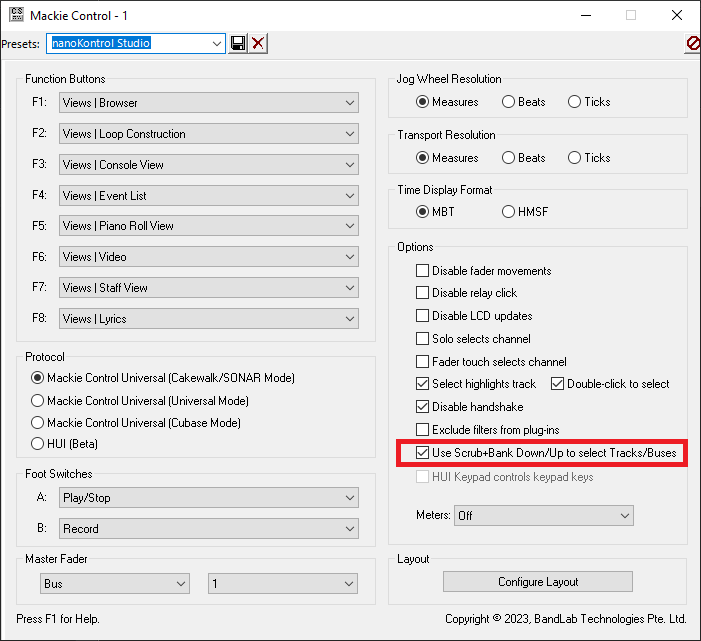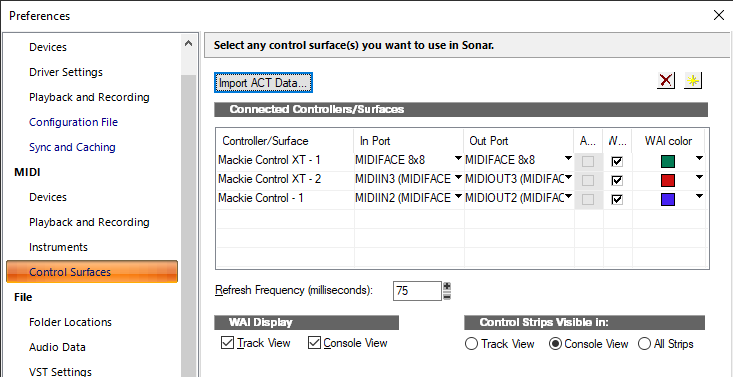-
Posts
7,209 -
Joined
-
Last visited
-
Days Won
39
Everything posted by msmcleod
-
Try holding down CTRL when clicking the Sonar shortcut. This will go through the set up of your configuration as if it was a new install.
-

Is there a way to recover a project file?
msmcleod replied to mgustavo's topic in Cakewalk by BandLab
There's no way to recover the project itself, but in the project Audio folder you should see previous versions of your wav files. The date/time stamp for the files should give you an indication as to what files were used just prior to your mistake It's not an easy task, but you could try: 1. Copying the relevant project wav files to a different folder 2. Dragging each one into a new audio track 3. Solo each track and try to identify the sections you wish to recover -
I use one of those too... I've had issues with their mouse driver tho.
-
There was an option added for the Korg nanoKONTROL Studio to allow the scrub button or loop button to be used as a SHIFT key along with the bank up/down buttons to select tracks or buses: To enable this, you need to check the "Use Scrub + Bank Down/Up to select Tracks/Buses" option in the Mackie Control dialog: Not saying this will definitely work with the X32, but worth a try.
-
You may also want to take a look at this article: https://medium.com/@stickgrinder/how-to-solve-the-infamous-windows-10-midi-device-renaming-issue-9aa793fa9f0a TLDR: Plugging lots of MIDI devices into different USB ports over time results in tonnes of MIDI device entries in the registry. This article shows you how to clean them up, and some advice for preventing it in the future.
-
@Ianshawn Smith - have you tried: 1. Closing Sonar 2. Renaming TTSSEQ.ini to TTSSEQ.ini.old ( in %APPDATA%\Cakewalk\Sonar ) 3. Restarting Sonar This should refresh the MIDI device list.
-
AZController won't help if the MIDI devices aren't showing up in the first place.
-
A few things to try: 1. Make sure your devices are plugged in / switched on before you start Sonar 2. Set your MIDI device mode to MME rather than UWP (note: you can only change device mode if no project is loaded)
-
This is more than likely BitBridge showing this message (the thing Sonar/Cakewalk uses to load 32 bit plugins). Chances are, the plugin its trying to load isn't there, or is having compatibility issues with a newer operating system.
-
I've just tried 2 x Mackie Control XT and a Mackie MCU without issues. I'm not sure what you mean about how Cakewalk labels the extenders - there is no labelling, just the MIDI port name which Cakewalk gets from Windows. You should be able to simply add the devices in order from left to right. So in my case, I've got Mackie XT #1 : channels 1 - 8, Mackie XT #2: channels 9 - 16, Mackie MCU: channels 17 - 24. I simply add them as follows in the Control Surface preferences dialog: Obviously if the Behringer units use USB for MIDI, you'll need to take care to set the correct MIDI ports, but apart from that, Cakewalk will automatically assign the strip channels in order you've added them. If you wanted the main unit to control channels 1-8, then extender #1: 9-16 / extender #2: 17-24, you'd add them as: Mackie Control Mackie Control XT Mackie Control XT
-
FWIW I've got an ancient 3rd gen i7, 4 core / 8 threads running at 3.4Ghz and 32GB RAM. I'm only using the on-board intel integrated graphics. I see massive improvements in Sonar over CbB especially with lower buffer sizes. In saying that, I'm using a newer version of Sonar than is currently public - more engine optimisations have been done over the past month that aren't yet public, but even so, the current public release still performs better than CbB in most projects for me.
-
Do you have the spectrum analyser turned on in the console view? Try turning it off - on some machines this can make a huge difference.
-
I've had this issue in the past a few times - in all but one of the cases, cleaning the contacts solved the issue. The case where it didn't work needed both the contact replaced on the PCB (using conductive silver paint), and the rubber contact switch replaced (this is literally a matter of lifting the old one off and putting the new one in place). Before opening it up, first try (in this order): 1. A vacuum cleaner across the keys 2. Spraying under/between the keys with a can of compressed air. 3. Try spraying some contact cleaner or WD40 in there while wiggling / playing the keys. WD40 is usually better than contact cleaner as it won't damage the carbon on the PCB / rubber contacts. Don't use switch cleaner - it's way too harsh. If all those fail, it's time to open it up and clean the contacts with Q-tips. If the contacts themselves are damaged, sometimes you can get away with using a pencil to replace the carbon, but that won't last forever... you can buy a conductive carbon (or silver) pen for $10 - $20 which will do the job properly. Obviously check everything with a multi-meter before you close up.
-
Time delay in ms is currently in development. It probably won't make the next update, but hopefully the one after.
- 1 reply
-
- 3
-

-

-

Exclude Tracks/Buses/Folders from View (Second Level Hiding)
msmcleod replied to murat k.'s topic in Feedback Loop
This seems overcomplicated to me. Why not just create presets in the Track Manager? You can then select which preset to use either using the Track Manager button drop down menu (in Sonar), or the Track Manager itself in either CbB/Sonar. -
I think the reason this was required was so that the command knows what automation to snapshot. Otherwise it has no way of knowing.
-

Instrument Definition with a VST?
msmcleod replied to Bill Campbell's topic in Instrument Definitions
There shouldn't be any need to go to these steps. Click on the Patch browser button, and you can choose definition for any .ins file you've imported, then search/select the patch from the list: -
Have you changed the Velocity trim (MIDI gain) control on the track?
-
It's working fine here, however the documentation is somewhat misleading: To create a snapshot of a track or bus parameter 1. Move the parameter control to where you want it. 2. Move the Now Time to the location where you want to create the snapshot. 3. Right-click the control and choose Automation Snapshot in the pop-up menu. You don’t have to write-enable the track or bus module. An indicator will appear on the control to show that automation has been added, and a node will be added to the control's envelope on the track. 4. Make sure the appropriate Automation Read button is enabled, play your project and listen to the results. You can undo the snapshot by using the Undo command, or by taking another snapshot at the same Now Time. This is all true for right-clicking the control, however for the keyboard shortcut to work you do have to write enable the parameter (i.e. within the corresponding automation lane). The keyboard shortcut will take an automation snapshot for all write-enabled parameters.
-
I'd seriously consider shutting your PC down overnight. I used to have a PC tower that ran my email / source code / media server that was on constantly. I replaced it with a fanless low-powered PC primarily to cut down noise, but the saving in power usage was shocking... like several £100's over the course of a year... enough that I could buy a new guitar every year if I wanted.
-
Can you show more of the dialog? In particular the "What to Export" section.
-
Are you sure you don't mean Sound on Sound? - Overwrite mode literally overwrites what you've previously recorded. - Sound-on-Sound allows you to build up a track by recording several takes, whilst hearing the previous ones - Comping records several takes while muting the previous takes, so you can quick-comp the takes choosing the best bits afterwards.
-

Negative Track Delay ....here yet and why not?
msmcleod replied to Ian Pav's topic in Instruments & Effects
Actually, it is setting the Time+ to a negative value... but the key difference is to also be able to specify this in milliseconds, rather than the current implementation which is in musical ticks only. A lot of orchestral libraries require a negative millisecond delay. This is to account for things like the bow touching the string on a violin before it actually plays the note - i.e. you get the note to start early so you hear the "bow" effect, but the actual musical sound starts playing on grid. A delay in musical ticks is fine if you've got a single tempo in your project (you just workout how many milliseconds a tick is for that tempo, and enter that tick value), but if you've got tempo changes, then the actual length in milliseconds of each musical tick will change with every tempo change. Also, I believe the current implementation allows you to enter negative time, but doesn't actually respect it (it clamps it to zero). The workaround in CbB is complicated. Essentially, you have to add a positive delay for all other tracks, equal to the tick equivalent for the largest millisecond delay. For each tempo change, you're going to need a complete new set of tracks with a different delay. As to why it's not here yet - simple answer, is it's really complicated. The MIDI engine schedules groups of notes ahead of time in time windows (based on musical ticks). A negative delay requires scheduling notes early, meaning they might need to be added in an earlier time window, with the reverse being true for positive delays. Get it wrong, and you get doubled notes or missed notes (we suffered both issues in the early implementations of the negative articulation delay). Not only that, each and every MIDI event needs to be time adjusted, converting the millisecond value to its new tick value - this requires a lookup of the tempo map for every event. Add looping / user seeking in the timeline, and it gets complicated really fast. -
If you uncheck "Always Echo Current MIDI Track" in Preferences->MIDI->Playback and Recording, it'll stay set to None.



